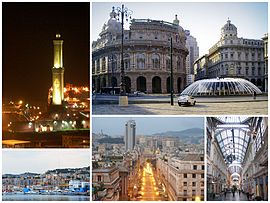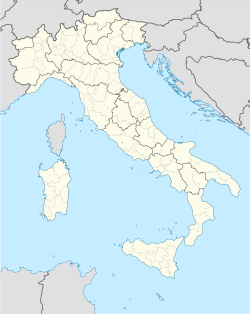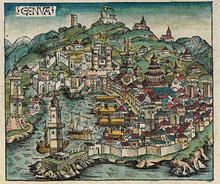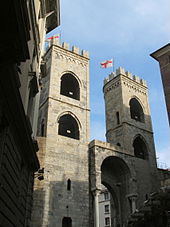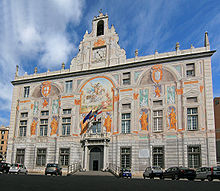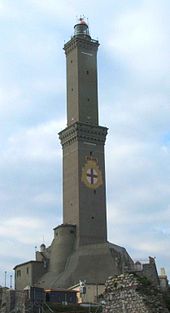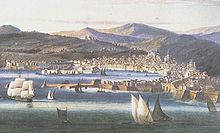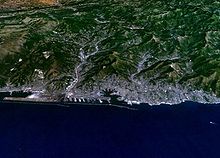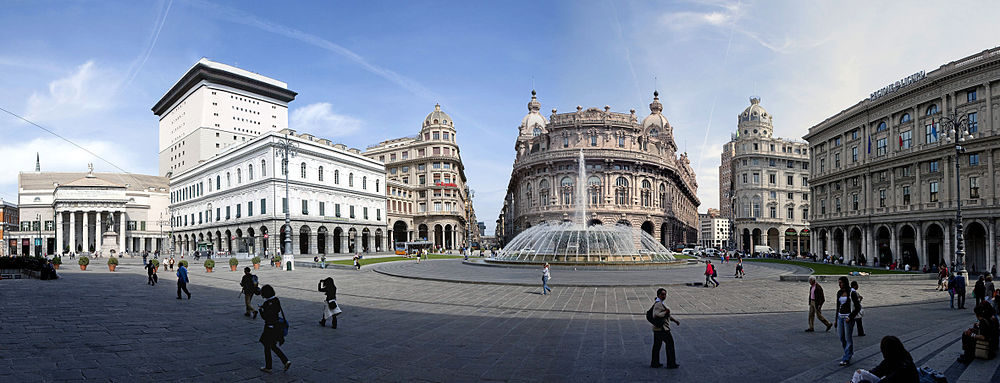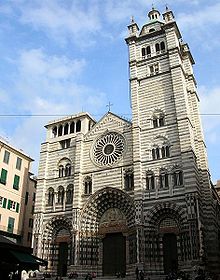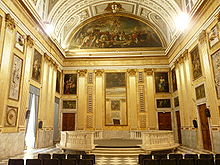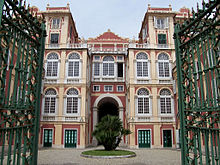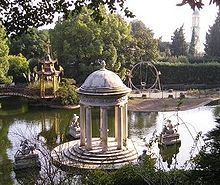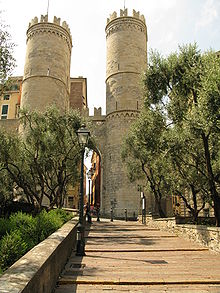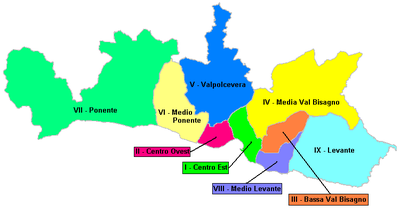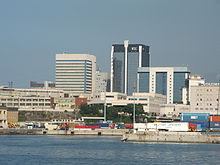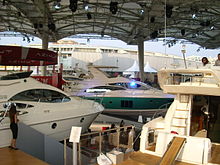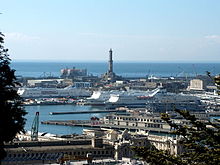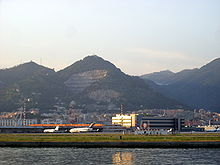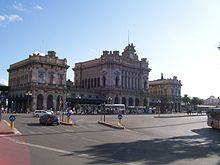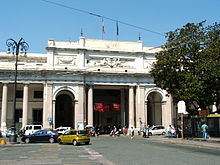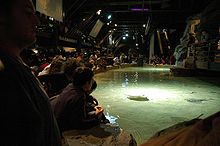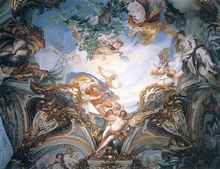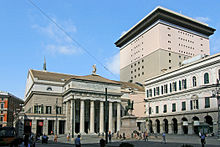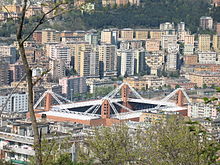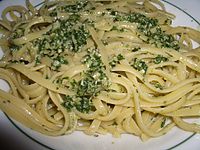
Genoa
Background to the schools Wikipedia
SOS Children made this Wikipedia selection alongside other schools resources. Child sponsorship helps children one by one http://www.sponsor-a-child.org.uk/.
| Genoa Genova |
|||
|---|---|---|---|
| — Comune — | |||
| Comune di Genova | |||
| A collage of Genoa, Clockwise from top left:Torre della Lanterna, Piazza de Ferrari, Galleria Mazzini, Brigata Liguria Street, View of San Teodoro from Genoa Port | |||
|
|||
|
|
|||
| Coordinates: 44°24′40″N 8°55′58″E Coordinates: 44°24′40″N 8°55′58″E | |||
| Country | Italy | ||
| Region | Liguria | ||
| Province | Genoa (GE) | ||
| Government | |||
| • Mayor | Marco Doria (Independent – Left Ecology Freedom) | ||
| Area | |||
| • Total | 243.60 km2 (94.05 sq mi) | ||
| Elevation | 20 m (70 ft) | ||
| Population (31 August 2011) | |||
| • Total | 608,154 | ||
| • Density | 2,500/km2 (6,500/sq mi) | ||
| Demonym | Genovesi | ||
| Time zone | CET ( UTC+1) | ||
| • Summer ( DST) | CEST ( UTC+2) | ||
| Postal code | 16121-16167 | ||
| Dialing code | 010 | ||
| Patron saint | John the Baptist | ||
| Saint day | June 24 | ||
| Website | Official website | ||
Genoa (pron.: / ˈ dʒ ɛ n oʊ . ə / Italian: Genova [ˈdʒɛːnova]; Genoese and Ligurian Zena [ˈzeːna]; Latin and, archaically, English Genua) is the capital of Liguria and the sixth largest city in Italy, with a population of 608,676 within its administrative limits on a land area of 243.6 km2 (94 sq mi). The urban zone of Genoa extends beyond the administrative city limits with a population of 718,896. The urban area of Genoa has a population of 800,709. In the metropolitan area live over 1.5 million people. Genoa is one of Europe's largest cities on the Mediterranean Sea and the largest seaport in Italy.
Genoa has been nicknamed la Superba ("the Superb one") due to its glorious past and impressive landmarks. Part of the old town of Genoa was inscribed on the World Heritage List (UNESCO) in 2006 (see below). The city's rich art, music, gastronomy, architecture and history, allowed it to become the 2004 European Capital of Culture. It is the birthplace of Christopher Columbus.
Genoa, which forms the southern corner of the Milan-Turin-Genoa industrial triangle of north-west Italy, is one of the country’s major economic centres. The city has hosted massive shipyards and steelworks since the 19th century, and its solid financial sector dates back to the Middle Ages. The Bank of Saint George, founded in 1407, is among the oldest in the world and plays an important role in the city’s prosperity since the middle of the 15th century. Today a number of leading Italian companies are based in the city, including Fincantieri, Ansaldo Energia, Ansaldo STS and Edoardo Raffinerie Garrone.
Etymology
Genua was a city of the ancient Ligurians. Its name may derive from the Latin word meaning "knee" (genu; plural, genua), i.e. "angle", from its geographical position at the centre of the Ligurian coastal arch, or it could derive from the Celtic root genu-, genawa (pl. genowe), meaning "mouth", i.e., estuary; thus akin to the name of Geneva.
Flag
The flag of Genoa is simply a St George's Cross, a red cross on a lime white field, identical to the Flag of England and incorporated into the Flag of Georgia.
Some historians believe that the Flag of England derives from the flag of Genoa, which originates as far back as 1096. On the origins of the flag the Duke of Kent remarked:
"The St. George's flag, a red cross on a white field, was adopted by England and the City of London in 1190 for their ships entering the Mediterranean to benefit from the protection of the Genoese fleet. The English Monarch paid an annual tribute to the Doge of Genoa for this privilege."
HRH The Duke of Kent
History
Ancient era and early Middle Ages
Genoa's history goes back to ancient times. The first historically known inhabitants of the area are the Ligures.
A city cemetery, dating from the 6th and 5th centuries BC, testifies to the occupation of the site by the Greeks, but the fine harbour was probably in use much earlier, perhaps by the Etruscans. It is also probable that the Phoenicians had bases in Genoa, or in the nearby area, since an inscription with an alphabet similar to that used in Tyre has been found.
In the Roman era, Genoa was overshadowed by the powerful Marseille and Vada Sabatia, near modern Savona. Different from other Ligures and Celt settlements of the area, it was allied to Rome through a foedus aequum ("Equal pact") in the course of the Second Punic War. It was therefore destroyed by the Carthaginians in 209 BC. The town was rebuilt and, after the end of the Carthaginian Wars, received municipal rights. The original castrum thenceforth expanded towards the current areas of Santa Maria di Castello and the San Lorenzo promontory. Genoese trades included skins, wood, and honey. Goods were shipped to the mainland from Genoa, up to major cities like Tortona and Piacenza.
After the fall of the Western Roman Empire, Genoa was occupied by the Ostrogoths. After the Gothic War, the Eastern Romans made it the seat of their vicar. When the Lombards invaded Italy in 568, the Bishop of Milan fled and held his seat in Genoa. Pope Gregory the Great was closely connected to these bishops in exile, for example involving himself the election of Deusdedit. The Lombards, under King Rothari, finally captured Genoa and other Ligurian cities in about 643. In 773 the Lombard Kingdom was annexed by the Frank empire; the first Carolingian count of Genoa was Ademarus, who was given the title praefectus civitatis Genuensis. Ademarus died in Corsica while fighting against the Saracens. In this period the Roman walls, destroyed by the Lombards, were rebuilt and extended.
For the following several centuries, Genoa was little more than a small centre, slowly building its merchant fleet which was to become the leading commercial carrier of the Mediterranean Sea. The town was sacked and burned in 934 by North African pirates and likely abandoned for a few years.
In the 10th century the city, now part of the Marca Januensis (" Genoese March") was under the Obertenghi family, whose first member was Obertus I. Genoa was one of the first cities in Italy to have some citizenship rights granted by local feudatories.
Middle Ages and Renaissance
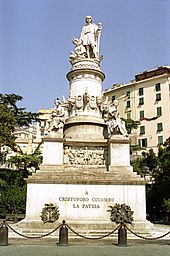
Before 1100, Genoa emerged as an independent city-state, one of a number of Italian city-states during this period. Nominally, the Holy Roman Emperor was overlord and the Bishop of Genoa was president of the city; however, actual power was wielded by a number of " consuls" annually elected by popular assembly. Genoa was one of the so-called "Maritime Republics" ( Repubbliche Marinare), along with Venice, Pisa, and Amalfi and trade, shipbuilding and banking helped support one of the largest and most powerful navies in the Mediterranean. The Adorno, Campofregoso, and other smaller merchant families all fought for power in this Republic, as the power of the consuls allowed each family faction to gain wealth and power in the city. The Republic of Genoa extended over modern Liguria and Piedmont, Sardinia, Corsica, Nice and had practically complete control of the Tyrrhenian Sea. Through Genoese participation on the Crusades, colonies were established in the Middle East, in the Aegean, in Sicily and Northern Africa. Genoese Crusaders brought home a green glass goblet from the Levant, which Genoese long regarded as the Holy Grail. Not all of Genoa's merchandise was so innocuous, however, as medieval Genoa became a major player in the slave trade.
The collapse of the Crusader States was offset by Genoa’s alliance with the Eastern Roman Empire. As Venice's relations with the Eastern Roman Empire were temporarily disrupted by the Fourth Crusade and its aftermath, Genoa was able to improve its position. Genoa took advantage of this opportunity to expand into the Black Sea and Crimea. Internal feuds between the powerful families, the Grimaldi and Fieschi, the Doria, Spinola, and others caused much disruption, but in general the republic was run much as a business affair. In 1218–1220 Genoa was served by the Guelph podestà Rambertino Buvalelli, who probably introduced Occitan literature to the city, which was soon to boast such troubadours as Jacme Grils, Lanfranc Cigala, and Bonifaci Calvo. Genoa's political zenith came with its victory over the Republic of Pisa at the naval Battle of Meloria in 1284, and with a temporary victory over its rival, Venice, at the naval Battle of Curzola in 1298.
However, this prosperity did not last. The Black Death was imported into Europe in 1347 from the Genoese trading post at Caffa ( Theodosia) in Crimea, on the Black Sea. Following the economic and population collapse, Genoa adopted the Venetian model of government, and was presided over by a doge (see Doge of Genoa). The wars with Venice continued, and the War of Chioggia (1378–1381)-- where Genoa almost managed to decisively subdue Venice—ended with Venice's recovery of dominance in the Adriatic. In 1390 Genoa initiated a crusade against the Barbary pirates with help from the French and laid siege to Mahdia. Though it has not been well-studied, the fifteenth century seems to have been a tumultuous time for Genoa. After a period of French domination from 1394–1409, Genoa came under rule by the Visconti of Milan. Genoa lost Sardinia to Aragon, Corsica to internal revolt and its Middle Eastern, Eastern European and Asia Minor colonies to the Turkish Ottoman Empire.
Genoa was able to stabilize its position as it moved into the sixteenth century, particularly thanks to the efforts of Andrea Doria, who established a new constitution in 1528, making Genoa a satellite of the Spanish Empire. Under the ensuing economic recovery, many aristocratic Genoese families, such as the Balbi, Doria, Grimaldi, Pallavicini, and Serra, amassed tremendous fortunes. According to Felipe Fernandez-Armesto and others, the practices Genoa developed in the Mediterranean (such as chattel slavery) were crucial in the exploration and exploitation of the New World. Christopher Columbus, for example, was a native of Genoa and donated one-tenth of his income from the discovery of the Americas for Spain to the Bank of Saint George in Genoa for the relief of taxation on foods.
At the time of Genoa’s peak in the 16th century, the city attracted many artists, including Rubens, Caravaggio and Van Dyck. The famed architect Galeazzo Alessi (1512–1572) designed many of the city’s splendid palazzi, as did in the decades that followed by fifty years Bartolomeo Bianco (1590–1657), designer of centrepieces of University of Genoa. A number of Genoese Baroque and Rococo artists settled elsewhere and a number of local artists became prominent.
The plague killed as many as half of the inhabitants of Genoa in 1656–57.
In May 1625 the French-Savoian army that invaded the Republic was successfully driven out by the combined Spanish and Geonese armies.In May 1684, as a punishment for Genoese support for Spain, the city was subjected to a French naval bombardment, with some 13,000 cannonballs aimed at the city.
It was occupied by Austria in 1746 during the War of the Austrian Succession. This episode in the city's history is mainly remembered for the Genoese revolt, precipitated by a boy named Giovan Battista Perasso and nicknamed Balilla, who threw a stone at an Austrian official and became a national hero to later generations of Genoese (and Italians in general).
Being unable to retain its rule in Corsica, where the rebel Corsican Republic was proclaimed in 1755, in 1768 Genoa was forced by the endemic rebellion to sell its claim to Corsica to the French, in the Treaty of Versailles of 1768.
Modern history
With the shift in world economy and trade routes to the New World and away from the Mediterranean, Genoa's political and economic power went into steady decline. In 1797, under pressure from Napoleon, Genoa became a French protectorate called the Ligurian Republic, which was annexed by France in 1805. This affair is commemorated in the famous first sentence of Tolstoy's War and Peace:
"Well, Prince, so Genoa and Lucca are now just family estates of the Buonapartes.(...) And what do you think of this latest comedy, the coronation at Milan, the comedy of the people of Genoa and Lucca laying their petitions [to be annexed to France] before Monsieur Buonaparte, and Monsieur Buonaparte sitting on a throne and granting the petitions of the nations?" (spoken by a thoroughly anti-Boanapartist Russian aristocrat, soon after the news reached Saint Petersburg).
Although the Genoese revolted against France in 1814 and liberated the city on their own, delegates at the Congress of Vienna sanctioned its incorporation into Piedmont ( Kingdom of Sardinia), thus ending the three century old struggle by the House of Savoy to acquire the city.
The city soon gained a reputation as a hotbed of anti-Savoy republican agitation (having its climax in 1849 with the Sack of Genoa), although the union with Savoy was economically very beneficial. With the growth of the Risorgimento movement, the Genoese turned their struggles from Giuseppe Mazzini's vision of a local republic into a struggle for a unified Italy under a liberalized Savoy monarchy. In 1860, General Giuseppe Garibaldi set out from Genoa with over a thousand volunteers to begin the conquest of Southern Italy. Today a monument is set on the rock where the patriots departed from.
In the late 1800s and the early 1900s, Genoa consolidated its role as a major seaport and an important steel and shipbuilding centre. During World War II Genoa suffered heavy damages. In a well-known episode, the British fleet bombarded Genoa and one shell fell into the cathedral of San Lorenzo without exploding. It is now available to public viewing on the cathedral premises. The city was liberated by the partisans a few days before the arrival of the Allies.
In the post-war years, Genoa played a pivotal role in the Italian economic miracle, as the third corner of the so-called "Industrial Triangle" of northern Italy, formed by the manufacturer hubs of Milan and Turin and the seaport of Genoa itself. Since 1962, the Genoa International Boat Show has evolved as one of the largest annually recurring events in Genoa. The 27th G8 summit in the city, in July 2001, was overshadowed by violent protests, with one protester, Carlo Giuliani, killed amid accusations of police brutality. In 2007 15 officials, who included police, prison officials and two doctors, were found guilty by an Italian court of mistreating protesters. A judge handed down prison sentences ranging from five months to five years. In 2004, the European Union designated Genoa as the European Capital of Culture, along with the French city of Lille.
Geography
The city of Genoa covers an area of 243 square kilometres (94 sq mi) between the Ligurian Sea and the Apennine Mountains. The city stretches along the coast for about 30 kilometres (19 mi) from the neighbourhood of Voltri to Nervi, and for 10 kilometres (6.2 mi) from the coast to the north along the valleys Polcevera and Bisagno. The territory of Genoa can then be popularly divided into 5 main zones: the centre, the west, the east, the Polcevera and the Bisagno Valley.
Genoa is adjacent to two popular Ligurian vacation spots, Camogli and Portofino. In the metropolitan area of Genoa lies Aveto Natural Regional Park.
Climate
Genoa has a borderline humid subtropical (Cfa) and Mediterranean climate (Csa), since only one summer month has less than 40 millimetres (1.6 in) of rainfall, preventing it from being classified as solely humid subtropical or Mediterranean.
The average yearly temperature is around 19 °C (66 °F) during the day and 13 °C (55 °F) at night. In the coldest months: December, January and February, the average temperature is 12 °C (54 °F) during the day and 6 °C (43 °F) at night. In the warmest month – July and August – the average temperature is 27.5 °C (82 °F) during the day and 21 °C (70 °F) at night. Generally – summer's/holiday season lasts about 4 to 6 months, from May/June to September/October. The daily temperature range is limited, with an average range of about 6 °C (43 °F) between high and low temperatures.
The city has never recorded temperatures below zero during the day. Annually, the average 2.9 of nights recorded temperatures of ≤0 °C (32 °F) (mainly in January). The coldest temperature ever recorded was −6.8 °C (20 °F) on the night of January 1985; the highest temperature ever recorded during the day is 35.4 °C (96 °F) on the July 1971 and August 1990. Average annual number of days with temperatures of ≥30 °C (86 °F) is about 8, average four days in July and August.
Average annual temperature of the sea is 17.5 °C (64 °F), from 13 °C (55 °F) in the period January–March to 25 °C (77 °F) in August. In the period from June to October, the average sea temperature exceeds 19 °C (66 °F).
Genoa is also a windy city, especially during winter when northern winds often bring cool air from the Po Valley (usually accompanied by lower temperatures, high pressure and clear skies). Another typical wind blows from southeast, mostly as a consequence of atlantic disturbances and storms, bringing humid and warmer air from the sea. Snowfall is sporadic, but does occur once or twice per year.
Annual average relative humidity is 68%, ranging from 63% in February to 73% in May.
Sunshine hours total above 2,200 per year, from an average 4 hours of sunshine duration per day in winter to average 9 hours in summer. This value is an average between the northern half of Europe and North Africa.
| Climate data for Genoa | |||||||||||||
|---|---|---|---|---|---|---|---|---|---|---|---|---|---|
| Month | Jan | Feb | Mar | Apr | May | Jun | Jul | Aug | Sep | Oct | Nov | Dec | Year |
| Average high °C (°F) | 11.5 (52.7) |
12.2 (54) |
14.6 (58.3) |
16.8 (62.2) |
20.5 (68.9) |
23.9 (75) |
27.3 (81.1) |
27.7 (81.9) |
24.4 (75.9) |
20.0 (68) |
15.1 (59.2) |
12.5 (54.5) |
18.9 (66) |
| Daily mean °C (°F) | 8.5 (47.3) |
9.1 (48.4) |
11.4 (52.5) |
13.7 (56.7) |
17.4 (63.3) |
20.8 (69.4) |
24.1 (75.4) |
24.4 (75.9) |
21.1 (70) |
16.9 (62.4) |
12.2 (54) |
9.5 (49.1) |
15.7 (60.3) |
| Average low °C (°F) | 5.5 (41.9) |
6.0 (42.8) |
8.2 (46.8) |
10.5 (50.9) |
14.2 (57.6) |
17.6 (63.7) |
20.9 (69.6) |
21.0 (69.8) |
17.9 (64.2) |
13.8 (56.8) |
9.2 (48.6) |
6.5 (43.7) |
12.6 (54.7) |
| Rainfall mm (inches) | 101.8 (4.008) |
74.0 (2.913) |
81.7 (3.217) |
88.0 (3.465) |
72.4 (2.85) |
58.2 (2.291) |
24.2 (0.953) |
69.3 (2.728) |
136.4 (5.37) |
171.3 (6.744) |
108.8 (4.283) |
93.1 (3.665) |
1,079.2 (42.488) |
| Avg. rainy days (≥ 1.0 mm) | 7.7 | 5.6 | 6.9 | 8.1 | 7.0 | 5.0 | 2.8 | 5.0 | 6.0 | 8.0 | 7.1 | 6.5 | 75.7 |
| Mean monthly sunshine hours | 117.8 | 130.5 | 158.1 | 192.0 | 220.1 | 246.0 | 294.5 | 266.6 | 201.0 | 173.6 | 111.0 | 111.6 | 2,222.8 |
| Source: Servizio Meteorologico, data of sunshine hours | |||||||||||||
Main sights
| Genoa: Le Strade Nuove and the system of the Palazzi dei Rolli | |
|---|---|
| Name as inscribed on the World Heritage List | |
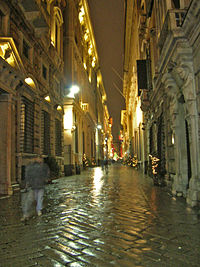 |
|
| Country | Italy |
| Type | Cultural |
| Criteria | ii, iv |
| Reference | 1211 |
| UNESCO region | Europe and North America |
| Inscription history | |
| Inscription | 2006 (30th Session) |
Monuments and places to see
Genoa's historic centre is one of the widest of Europe (about 400.000 m2). The structure of its oldest part is articulated in a maze of squares and narrow caruggi (typical genoese alleys). It joins a medieval dimension with following 16th-century and baroque interventions ( San Matteo square and the ancient via Aurea, now via Garibaldi).
Remains of the ancient 17th-century walls are still visible nearby San Lorenzo cathedral, the most attended place of worship of Genoa.
The symbols of the city are the Lanterna (the lighthouse) (117 m high), old and standing lighthouse visible in the distance from the sea (beyond 30 km), and the monumental fountain of Piazza De Ferrari, recently restored, out-and-out core of the city's life. Another par excellence tourist destination is the ancient seaside district of Boccadasse, with its picturesque multicolour boats, set as a seal to Corso Italia, the elegant promenade which runs along the Lido d'Albaro, and renowned for its famous ice-creams.
Just out of the city centre, but still part of the 33 kilometres of coast included in the municipality's territory, are Nervi, natural doorway to the Ligurian East Riviera, and Pegli, the point of access to the West Riviera.
The new Genoa most of all based its rebirth upon the restoration of the green areas of the immediate inland parts (among them the Regional Natural Park of Beigua) and upon the realization of facilities such as the Acquario in the Old Harbour - the biggest in Italy and one of the major in Europe - and its Marina (the tourist small port which holds hundreds of pleasure boats). All of this inside the restored Expo Area, arranged in occasion of the Columbian Celebrations of 1992.
The regained pride gave back to the city the consciousness of being capable of looking to the future without forgetting its past. The resumption of several flourishing hand-crafting activities, far-back absent from the caruggi of the old town, is a direct evidence of it.
The restoration of many of Genoa's churches and palaces in the 80's and the 90's contributed to the city's rebirth. A notable example the Renaissance Basilica of Santa Maria Assunta, sitting on the top of the hill of Carignano and visible from almost every part of the city.
The total restoration of Palazzo Ducale - once venue of doges and senators and nowadays location of cultural events - and of the Old Harbour and the rebuilding of Teatro Carlo Felice, destroyed by the Second World War bombings that only spared the neoclassic pronao of the architect Carlo Barabino, were two more points of strength for the realization of a new Genoa.
Another monument of relevant importance that has been restored to its former beauty is the monumental Cemetery of Staglieno, in which the mortal remains of several known personalities rest, among them Giuseppe Mazzini, Fabrizio De André and Oscar Wilde's wife. With its characteristic skyline that still today gives the impression of an insurmountable fortress, it is distinguished by its thick network of hill fortifications on wide walls, that in the past war times mede the cemetery impregnable both for the ground and sea attacks. Genoa could not renounce, especially as from the 1960s, to a great renewal, which as happened in several other metropolis, should necessarily get through the realization of big council houses' complexes, whose quality, utility and functionality has been and still is constroversial for those residents living there. Concerning this, the most known cases are those of the so-called "biscione", a development in the shape of a long snake, situated on the hills of the populous district of Marassi, and the one of the group of houses known as "Le Lavatrici" (the washing machines), in the district of Pra'. Because of other architectonic solutions that characterised it, since a few decades Genoa has become a sort of capital of the Italian modern architecture, as well as European. This is principally owed to Renzo Piano's work, that since the end of the 1980s has been dealing with the restoration of some of the most famous cities of the world. Piano acquired notoriety as from 1992, when Genoa hosted visitors in its Old Harbour, in occasion of the Columbian Celebrations ("Colombiadi"). The waterfront was completely restored and symbolized by the stylized "Great Bigo" (a sort of trademark of the genoese portual activity). Beyond a complete restyling of the area, the ancient portual zone nearby the Mandraccio opening, in Porta Siberia, was scenographically enriched by Piano himself with a big sphere made of metal and glass, installed in the port's waters, not far from the Acquario, and unveiled in 2001 in occasion of the G8 Summit held in Genoa. The sphere (called by the citizens "Piano's bubble' or "the ball"'"), after hosting an exposition of fens from Genoa's Botanical Gardens, houses now the reconstruciton of a tropical environment, with several plants, little animals and butterflies. Piano also projected the subway's stations and, in the hills area, the construction - in collaboration with UNESCO - of Punta Nave, base of the " Renzo Piano Building Workshop".
Nearby the Old Harbour the so-called "Matitone" can be seen, especially by who crosses the city centre by way of the elevated road (the "Sopraelevata"), controversial as well as peculiar skyscraper in shape of a pencil, that lays side by side with the group of the WTC towers, core of the San Benigno development, today base of part of the Municipality's administration and of several companies.
Churches
St. Lawrence Cathedral (Cattedrale di San Lorenzo) is the city's Cathedral, and is built in a Romanesque-Renaissance style. Other important and major churches in Genoa include the Church of San Donato, the Church of Sant'Agostino, the Oratory of San Giacomo della Marina, the Church of Santo Stefano, San Torpete and the Basilica della Santissima Annunziata del Vastato. Most of these churches and basilicas are built in the Romanesque style, even though the Basilica della Santissima Annunziata del Vastato is built in a rich and elaborate Baroque style.
Buildings and palaces
The main features of central Genoa include Piazza De Ferrari, around which are sited the Opera and the Palace of the Doges. There is also a house where Christopher Columbus is said to have been born.
Strada Nuova (now Via Garibaldi), in the old city, was inscribed on the World Heritage List in 2006. This district was designed in the mid-16th century to accommodate Mannerist palaces of the city's most eminent families, including Palazzo Rosso (now a museum), Palazzo Bianco, Palazzo Grimaldi and Palazzo Reale. Palazzo Bianco and Palazzo Rosso are also known as Musei di Strada Nuova. The famous art college is also located on this street.
Other landmarks of the city include Palazzo del Principe, the Old Harbour (Porto Antico), transformed into a mall by architect Renzo Piano, and the famous cemetery of Staglieno, renowned for its monuments and statues. The Edoardo Chiossone Museum of Oriental Art has one of the largest collections of Oriental art in Europe.
Genoa also has a large aquarium located in the above-mentioned old harbour. The port of Genoa also contains an ancient lighthouse, called " La Lanterna".
Parks
Genoa has 82,000 square metres of public parks in the city centre, such as Villetta Di Negro which is right in the heart of the town, overlooking the historical centre. Many bigger green spaces are situated outside the centre: in the east are the Parks of Nervi (96,000 sq m.) overlooking the sea, in the west the beautiful gardens of Villa Durazzo Pallavicini (265,000 sq m.). The numerous villas and palaces of the city also have their own gardens, like Palazzo del Principe, Villa Doria, Palazzo Bianco and Palazzo Tursi, Palazzo Nicolosio Lomellino, Albertis Castle, Villa Croce, Villa Imperiale Cattaneo, Villa Bombrini, and many more.
Promenades
Corso Italia runs for 2.5 kilometres in the quartiere of Albaro, linking two neighbourhoods of Foce and Boccadasse. The promenade, which was originally built in 1908, overlooks the sea, towards the promontory of Portofino, and the main landmarks are the small lighthouse of Punta Vagno, the San Giuliano Abbey, the Lido of Albaro.
Old harbour
The old harbour ("porto antico" in Italian) is the ancient part of the port of Genoa. The Genoese architect Renzo Piano redeveloped the area for public access, restoring the historical buildings (like the Cotton warehouses) and creating new landmarks like the Aquarium, the Bigo and recently the "Bolla" (the Sphere). The main touristic attractions of this area are the famous Aquarium and the Museum of the Sea (MuMA). In 2007 these attracted almost 1.7 million visitors.
Walls and fortresses
The city of Genoa during its long history at least since 9th century had been defended by different line of walls.
To this day, large portions of these walls remain, and Genoa has more and longer walls than any other city in Italy. The main city walls are known as “Ninth century walls”, "Barbarossa Walls" (12th century ), "Fourteenth century walls", "Sixteenth century walls" and "New Walls" ("Mura Nuove" in Italian), the more imposing, built in the first half of 17th century on the ridge of hills around the city, having a length of almost 20 kilometres. Some fortresses stand along the perimeter of the "New Walls" or close them.
Demographics
| Historical population | ||
|---|---|---|
| Year | Pop. | ±% |
| 1861 | 242,447 | — |
| 1871 | 256,486 | +5.8% |
| 1881 | 289,234 | +12.8% |
| 1901 | 377,610 | +30.6% |
| 1911 | 465,496 | +23.3% |
| 1921 | 541,562 | +16.3% |
| 1931 | 590,736 | +9.1% |
| 1936 | 634,646 | +7.4% |
| 1951 | 688,447 | +8.5% |
| 1961 | 784,194 | +13.9% |
| 1971 | 816,872 | +4.2% |
| 1981 | 762,895 | −6.6% |
| 1991 | 678,771 | −11.0% |
| 2001 | 610,307 | −10.1% |
| 2011 | 608,493 | −0.3% |
| Source: ISTAT 2001 | ||
At the beginning of 2011, there were 608,493 people residing in Genoa, of whom 47% were male and 53% were female. The city is characterized by rapid aging and a long history of demographic decline, that has shown a partial slowdown in the last decade. Genoa has the lowest birth rate and is the most aged of any large Italian city. Minors (children ages 18 and younger) totalled only 14.12% of the population compared to pensioners who number 26.67%. This compares with the Italian average of 18.06% (minors) and 19.94% (pensioners). The median age of Genoa's residents is 47, compared to the Italian average of 42. The current birth rate of the city is only 7.49 births per 1,000 inhabitants, compared to the national average of 9.45. As of 2006, 94.23% of the population was Italian. The largest immigrant group is from the Americas (mostly Ecuador): 2.76%, other European nations (mostly Albania, Ukraine, the former Yugoslavia and Romania): 1.37%, and North Africa: 0.62%. The city is predominantly Roman Catholic, with small numbers of Protestant adherents.
Administration
City government
The Municipal Council of Genoa is led by a left-wing majority, elected in May 2012. The mayor is Marco Doria, expression of a progressive alliance composed by Democratic Party, Italy of Values, Left Ecology Freedom, Communist Refoundation Party and other minor lists.
Administrative subdivision
The city of Genoa is subdivided into 9 Municipi (administrative districts), as approved by the Municipal Council in 2007.
| Municipio | Population (% of total) | Quarters included |
|---|---|---|
| Centro-Est | 91,402 (15.0%) | Pré, Molo, Maddalena, Oregina, Lagaccio, San Nicola, Castelletto, Manin, San Vincenzo, Carignano |
| Centro-Ovest | 66,626 (10.9%) | Sampierdarena, Campasso, San Teodoro, San Bartolomeo |
| Bassa Val Bisagno | 78,791 (12.9%) | San Fruttuoso, Marassi, Quezzi |
| Media Val Bisagno | 58,742 (9,6%) | Staglieno, Sant'Eusebio, San Gottardo, Molassana, Struppa |
| Valpolcevera | 62,492 (10.3%) | Borzoli, Fegino, Certosa, Rivarolo, Teglia, Begato, Bolzaneto, Morego, San Quirico, Pontedecimo |
| Medio Ponente | 61,810 (10.1%) | Sestri, Cornigliano, Campi |
| Ponente | 63,027 (10.3%) | Crevari, Voltri, Palmaro, Prà, Pegli, Multedo |
| Medio Levante | 61,759 (10.1%) | Foce, Brignole, Albaro, San Martino, San Giuliano, Lido, Puggia |
| Levante | 66,155 (10.8%) | Sturla, Quarto, Quinto, Nervi, Bavari, San Desiderio, Borgoratti |
Economy
Ligurian agriculture has increased its specialisation pattern in high-quality products (flowers, wine, olive oil) and has thus managed to maintain the gross value-added per worker at a level much higher than the national average (the difference was about 42% in 1999). The value of flower production represents over 75% of the agriculture sector turnover, followed by animal farming (11.2%) and vegetable growing (6.4%).
Steel, once a major industry during the booming 1950s and 1960s, phased out after the late 1980s crisis, as Italy moved away from the heavy industry to pursue more technologically advanced and less polluting productions.
So the Ligurian industry has turned towards a widely diversified range of high-quality and high-tech products (food, shipbuilding (in Sestri Ponente and in metropolitan area - Sestri Levante), electrical engineering and electronics, petrochemicals, aerospace etc.). Nonetheless, the regions still maintains a flourishing shipbuilding sector (yacht construction and maintenance, cruise liner building, military shipyards).
In the services sector, the gross value-added per worker in Liguria is 4% above the national average. This is due to the increasing diffusion of modern technologies, particularly in commerce and tourism. A good motorway network (376 km in 2000) makes communications with the border regions relatively easy. The main motorway is located along the coastline, connecting the main ports of Nice (in France), Savona, Genoa and La Spezia. The number of passenger cars per 1000 inhabitants (524 in 2001) is below the national average (584). On average, about 17 million tonnes of cargo are shipped from the main ports of the region and about 57 million tonnes enter the region. The Port of Genoa, with a trade volume of 58.6 million tonnes it is the first port of Italy, the second in terms of twenty-foot equivalent units after the port of transshipment of Gioia Tauro, with a trade volume of 1.86 million TEUs. The main destinations for the cargo-passenger traffic are Sicily, Sardinia, Corsica, Barcelona, and the Canary Islands.
The Genoa metropolitan area had a GDP amounting to $30.1 billion, and $33,003 per capita.
Transport
Ports
Several cruise and ferry lines serve the passenger terminals in the old port, with a traffic of 3.2 million passengers in 2007. MSC Cruises chose Genoa as one of its main home ports, in competition with the Genoese company Costa Cruises, which moved its home port to Savona. The quays of the passenger terminals extend over an area of 250 thousand square metres, with 5 equipped berths for cruise vessels and 13 for ferries, for an annual capacity of 4 million ferry passengers, 1.5 million cars and 250,000 trucks. The historical maritime station of Ponte dei Mille is today a technologically advanced cruise terminal, with facilities designed after the world's most modern airports, to ensure fast embarking and disembarking of latest generation ships carrying thousand passengers. A third cruise terminal is currently under construction in the redesigned area of Ponte Parodi, once a quay used for grain traffic.
Air transport
The Airport of Genoa ( IATA: GOA, ICAO: LIMJ) is built on an artificial peninsula, 4 NM (7.4 km; 4.6 mi) west of the city. The airport is currently operated by Aeroporto di Genova S.P.A., which has recently upgraded the airport complex, that now connects Genoa with several daily flights to Rome, Naples, Paris, London, Madrid and Munich. In 2008, 1,202,168 passengers travelled through the airport, with an increase of international destinations and charter flights.
Public transport
The main railway stations are Genoa Brignole and Genoa Principe, the first situated in the east side of the city centre, close to the business districts and the exhibition centre, while the second is in the west side, close to the port, the university and the historical centre. From these two stations depart the main trains connecting Genoa to France, Turin, Milan and Rome.
Genoa's third most important station is Genoa Sampierdarena, which serves the densely populated neighbourhood of Sampierdarena. A total of 23 other local stations serve the other neighbourhoods, on the 30-kilometre-long coast line from Nervi to Voltri, and on the northern line through Bolzaneto and the Polcevera Valley.
The municipal administration of Genoa is projecting to transform these urban railway lines to be part of the rapid transit system, which now consists of a light metro which connects Brin to the city centre and is called the Metropolitana di Genova ( Genoa Metro). The metro line is currently being extended to Brignole Station, with the opening of two new stations, Corvetto and Brignole, and this is expected to be completed in 2012. A possible further extension towards the eastern, densely populated boroughs was planned, but the municipal administration is keen to improve the public transport investing in new tram lines instead of completing the extension of the light metro. The current stations of the metro line are Brin-Certosa, Dinegro, Principe, Darsena, San Giorgio, Sant'Agostino and De Ferrari, and the line is 5.3 km (3.3 mi) long.
The city's bus and trolleybus network is operated by AMT ( it/ de) (Azienda Mobilità e Trasporti SpA). There is also the Drin Bus - demand responsive transport service (DRT) that connects the hilly, low-density areas of Genoa.
Education
The first organized forms of higher education in Genoa date back to the 13th century when private colleges were entitled to award degrees in Medicine, Philosophy, Theology, Law, Arts. Today the University of Genoa, founded in the 15th century, is one of the largest in Italy, with 11 faculties, 51 departments and 14 libraries. In 2007–2008, the University had 41,000 students and 6,540 graduates.
Genoa is also home to other colleges and academies:
- The Italian Shipping Academy
- The Ligurian Academy of Fine Arts
- The " Niccolò Paganini" Conservatory
- The Italian Hydrographic Institute
- The Grazia Deledda Academy and School
The Italian Institute of Technology was established in 2003 jointly by the Italian Ministry of Education, Universities and Research and the Italian Minister of Economy and Finance, to promote excellence in basic and applied research. The main fields of research of the Institute are Neuroscience, Robotics, Nanotechnology, Drug discovery. The central research labs and headquarters are located in Morego, in the neighbourhood of Bolzaneto.
Clemson University, based in South Carolina, United States has a villa in Genoa where architecture students and students in related fields can attend for a semester or year-long study program.
Florida International University (FIU), based in Miami, Florida, United States also has a small campus in Genoa, with the University of Genoa, which offers classes within the FIU School of Architecture.
Culture
The Aquarium of Genoa
The Aquarium of Genoa (in Italian: Acquario di Genova) is the largest aquarium in Italy and the second largest in Europe. Built for Genoa Expo '92, the Aquarium of Genoa is an educational, scientific and cultural centre. Its mission is to educate and raise public awareness as regards conservation, management and responsible use of aquatic environments. It welcomes over 1.2 million visitors a year. Control of the entire environment, including the temperature, filtration, and lighting of the tanks was provided by local Automation Supplier Orsi Automazione, acquired in 2001 by Siemens. The Aquarium of Genoa is co-ordinating the AquaRing EU project. It also provides scientific expertise and a great deal of content for AquaRing, including documents, images, academic content and interactive online courses, via its Online Resource Centre.
Art
Genoa has a rich artistic history, with numerous frescos, paintings, sculptures and other works of art held in the city's abundant museums, palaces, villas, art galleries and piazzas. Genoa is the birthplace and home of the 'Ligurian School', where the key figures were several native and foreign painters, such as Rubens, Van Dyck and Bernardo Strozzi.
Much of the city's art is found in its churches and palaces, where there are numerous Renaissance, Baroque and Rococo frescos, such as in the Genoa Cathedral, the Church of Gesù and the Church of San Donato.
Genoa is also famous for its numerous tapestries, which decorated the city's many salons. Whilst the patrician palaces and villas in the city were and still are austere and majestic, the interiors tended to be luxurious and elaborate, often full of tapestries, many of which were Flemish.
Language
The Genoese dialect (Zeneize) is the most important dialect of the Ligurian language, and is commonly spoken in Genoa alongside Italian.
Ligurian is listed by Ethnologue as a language in its own right, of the Romance branch, and not to be confused with the ancient Ligurian language. Like the languages of Lombardy, Piedmont, and surrounding regions, it is of Gallo-Italic derivation.
Other sights
Music
The Teatro Carlo Felice, built in 1828 in the city in the Piazza De Ferrari, and named for the monarch of the then Kingdom of Sardinia (which included the present regions of Sardinia, Piedmont and Liguria). The theatre was the centre of music and social life in the 19th century. On various occasions in the history of the theatre, presentations have been conducted by Mascagni, Richard Strauss, Hindemith and Stravinsky.
On the occasion of the Christopher Columbus celebration in 1992, new musical life was given to the area around the old port, including the restoration of the house of Paganini and presentations of the Trallalero, the traditional singing of Genoese dock workers. Additionally, the city is the site of the Teatro Gustavo Modena, the only theatre to have survived the bombings of World War II relatively intact. The city is the site of the Niccolò Paganini music conservatory. In the town of Santa Margherita Ligure, the ancient Abbey of Cervara is often the site of chamber music concerts.
The city has also a tradition of folk music in Genoese dialect, like the trallalero (a polyphonic vocal music, performed by five men) and several songs, including the well-known piece " Ma se ghe penso" (English: "But if I think about it"), a nostalgic memory of Genoa by an emigrant to Argentina.
Sports
There are two major football teams in Genoa: Genoa Cricket and Football Club and U.C. Sampdoria; Genoa Cricket and Football Club is the oldest football club in Italy. The football section of the club was founded in 1893 by James Richardson Spensley, an English doctor, and has won 9 championships (between 1898 and 1924) and 1 Italy Cup (season 1936/1937). U.C. Sampdoria was founded in 1946 from the merger of two existing clubs, Andrea Doria (founded in 1895) and Sampierdarenese (founded in 1911). Sampdoria has won one Italian championship ( Serie A – Season 1990–1991), 4 Italy Cups, 1 UEFA Cup Winners' Cup in 1989/90 and 1 Italian Super Cup. Both Genoa C.F.C. and U.C. Sampdoria play their home games in the Luigi Ferraris Stadium, which holds 36,536 spectators.
People
Famous Genoese include Sinibaldo and Ottobuono Fieschi (Popes Innocent IV and Adrian V) and Pope Benedict XV, navigators Christopher Columbus, Antonio de Noli, Enrico Alberto d'Albertis, Enrico de Candia ( Henry, Count of Malta) and Andrea Doria, composers Niccolò Paganini and Michele Novaro, Italian patriots Giuseppe Mazzini, Goffredo Mameli and Nino Bixio, writer and translator Fernanda Pivano, poet Edoardo Sanguineti, Communist politician Palmiro Togliatti, architect Renzo Piano, Physics 2002 Nobel Prize winner Riccardo Giacconi, Literature 1975 Nobel Prize winner Eugenio Montale, the court painter Giovanni Maria delle Piane (Il Mulinaretto) from the Delle Piane family, artists Vanessa Beecroft, Enrico Accatino, comedians Gilberto Govi, Paolo Villaggio, Beppe Grillo, Luca Bizzarri, Paolo Kessisoglu and Maurizio Crozza; singer-songwriters Fabrizio de André, Luigi Tenco, Ivano Fossati, Gino Paoli, Umberto Bindi, Bruno Lauzi, Francesco Baccini; actor Vittorio Gassman, and actress Moana Pozzi, Giorgio Parodi who conceived the motorcycle company Moto Guzzi with Carlo Guzzi and Giovanni Ravelli. Some reports say the navigator & explorer Giovanni Caboto (John Cabot) was also from Genoa, others say he was from Savona. Saints from Genoa include Romulus, Catherine. Among the latest generations, musicians like Andrea Bacchetti, Giulio Plotino, Sergio Ciomei, Lorenzo Cavasanti, Stefano Bagliano and Fabrizio Cipriani, as well as academics and authors like Michele Giugliano and Roberto Dillon, help in keeping the name of the city on the international spotlight in different fields among the arts, technology and culture.
Cuisine
Popular foods local to Genoa include pesto sauce, focaccia, farinata, stoccafisso ( stockfish), and salsa di noci (walnut sauce). Pasta (usually trofie) al Pesto is probably the most iconic among Genoese foods. Pesto sauce is prepared with fresh basil, pine nuts, grated parmesan, garlic and olive oil pounded together. Another popular dish which is common to Genoa is the minestrone, a thick soup made out of several vegetables and legumes, such as potatoes, beans, green beans, cabbages, pumpkins and zucchini. Other soup dishes which are common to the city include the fish-consisting ciuppin (the precursor to San Francisco's cioppino, buridda, zemin (a soup with garbanzo beans), sbira and preboggion. Other specialties are Ravioli al sugo (Ravioeu ao tocco), Pansoti di Rapallo (round ravioli filled with hard-boiled egg, spinach and grated cheese), Cappon Magro, Pandolce (Pandoçe) and Sacripantina. Is also known for its cheese filled pizza crust (focaccia al formaggio), although it is mainly typical of Recco (a town in the eastern Riviera), not far from Genoa.
External relations
Twin towns:
- Baltimore,
 United States
United States - Chios,
 Greece
Greece - Columbus,
 United States
United States - Odessa,
 Ukraine
Ukraine - Marseille,
 France
France - Rijeka,
 Croatia
Croatia
Bilateral agreements:
- Guayaquil,
 Ecuador
Ecuador - Havana,
 Cuba
Cuba - Barcelona,
 Spain
Spain - Dalian,
 China
China - Marseille,
 France
France - Belém,
 Brazil
Brazil - Athens,
 Greece
Greece - Lille,
 France
France - Saint Petersburg,
 Russia
Russia - Yekaterinburg,
 Russia
Russia - Acqui Terme,
 Italy
Italy - Moscow,
 Russia
Russia - Varna,
 Bulgaria
Bulgaria - Mantua,
 Italy
Italy - Cremona,
 Italy
Italy - Ovada,
 Italy
Italy - Constanța,
 Romania
Romania - Turin,
 Italy
Italy - Deva,
 Romania
Romania - Siena,
 Italy
Italy - Odessa,
 Ukraine
Ukraine - Kiev,
 Ukraine
Ukraine - Nice,
 France
France - La Paz,
 Bolivia
Bolivia - Azuchi,
 Japan
Japan - Bogotá,
 Colombia
Colombia - Valparaíso,
 Chile
Chile - Buenos Aires,
 Argentina
Argentina - Capo di Ponte,
 Italy
Italy - Castelsardo,
 Italy
Italy - Santo Domingo,
 Dominican Republic
Dominican Republic - Tursi,
 Italy
Italy - Pointe Noire,
 Congo
Congo - Kaolack,
 Senegal
Senegal - Lattakia,
 Syria
Syria - Galata,
 Turkey
Turkey - Hebron,
 Palestine
Palestine - El Mina,
 Lebanon
Lebanon - Pizzo Calabro,
 Italy
Italy - Polokwane,
 South Africa
South Africa - Sousse,
 Tunisia
Tunisia - Lyon,
 France
France
